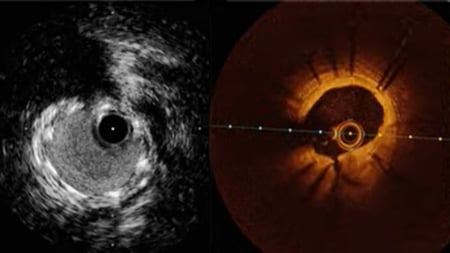Effect of P2Y12 inhibitor monotherapy vs dual antiplatelet therapy on cardiovascular events in patients undergoing percutaneous coronary intervention
Selected in JAMA by D. Giacoppo
Results of the SMART-CHOICE randomized clinical trial
References
Authors
Hahn JY, Song YB, Oh JH, Chun WJ, Park YH, Jang WJ, Im ES, Jeong JO, Cho BR, Oh SK, Yun KH, Cho DK, Lee JY, Koh YY, Bae JW, Choi JW, Lee WS, Yoon HJ, Lee SU, Cho JH, Choi WG, Rha SW, Lee JM, Park TK, Yang JH, Choi JH, Choi SH, Lee SH, Gwon HC; SMART-CHOICE Investigators
Reference
JAMA. 2019 Jun 25;321(24):2428-2437
Published
June 2019
Link
Read the abstractReviewer
My Comment
Why this study – the rationale/objective?
Antiplatelet therapy composition and duration after percutaneous coronary intervention (PCI) has been a matter of debate in recent years.
Several recent trials showed comparable outcomes between short and prolonged dual antiplatelet therapy (DAPT) regimens after drug-eluting stent (DES) implantation. However, the single existing trial with statistical power for stent thrombosis, though having a different design, showed inconsistent findings and results from available studies were not univocal in the setting of acute coronary syndrome and complex coronary artery disease. Finally, current evidence about short versus prolonged regimens mostly refers to DAPT versus aspirin monotherapy following P2Y12 platelet receptor inhibitor interruption.
The SMART-CHOICE trial sought to explore 12-month clinical outcomes after second-generation DES implantation by comparing patients randomized to 3 months of DAPT followed by P2Y12 platelet receptor inhibitor monotherapy with those randomized to 12 months of DAPT.
How was it executed – the methodology?
The SMART-CHOICE trial was an investigator-initiated, open-label, prospective, randomized study comparing 3 months of DAPT followed by P2Y12 platelet receptor inhibitor monotherapy with 12 months of DAPT.
A total of 2993 patients undergoing PCI with second-generation DES were enrolled at 33 centers in South Korea. Randomization in a 1:1 ratio was performed at the index procedure or 3 months following DES implantation. All patients received 300 mg of aspirin and 300-600 mg of clopidogrel, 180 mg of ticagrelor, or 60 mg of prasugrel unless they were not already taking DAPT. After procedure 100 mg of aspirin once daily and 75 mg of clopidogrel once daily, 90 mg of ticagrelor twice daily, or 10 mg of prasugrel once daily were given.
The primary endpoint was a composite of all-cause death, myocardial infarction, or stroke at 12 months. The study was designed to prove the noninferiority of 3 months of DAPT followed by P2Y12 platelet receptor inhibitor monotherapy compared with 12 months of DAPT with a margin of 1.8% that was equivalent to a 45% increase in the expected rate of 4.0%.
What is the main result?
At 12 months, the primary endpoint occurred in 42 patients assigned to 3 months of DAPT and 36 patients assigned to 12 months of DAPT, corresponding to 2.9% and 2.5% cumulative incidences respectively. The noninferiority of 3 months of DAPT compared with 12 months of DAPT was met with respect to the primary endpoint (pnoninferiority = 0.007; psuperiority = 0.46) and the risk was similar between groups (HR 1.19, 95% CI 0.76-1.85). The results did not change in the per-protocol analysis (pnoninferiority = 0.02). By applying a landmark time point at 90 days, no differences in the occurrence of events between groups over follow-up time were observed.
Similar incidences in the individual endpoints of all-cause death (1.4% vs. 1.2%, p = 0.61; HR 1.18, 95% CI 0.63-2.21), myocardial infarction (0.8% vs. 1.2%, p = 0.28; HR 0.66, 95% CI 0.31-1.40), stent thrombosis (0.2% vs. 0.1%, p = 0.65; HR 1.51, 95% CI 0.25-9.02), and stroke (0.8% vs. 0.3%, p = 0.14; HR 2.23, 95% CI 0.78-6.43) occurred between groups.
Bleeding Academic Research Consortium (BARC) type 2-5 was significantly lower with short DAPT compared with prolonged DAPT (2.0% vs. 3.4%, p = 0.02; HR 0.58, 95% CI 0.36-0.92), though BARC type 3-5 (major bleeding) did not significantly differ between groups (0.8% vs. 1.0%, p = 0.72; HR 0.87, 95% CI 0.40-1.88). The net composite endpoint including all-cause death, myocardial infarction, stroke, or BARC type 2-5 was comparable between 3 and 12 months of DAPT (4.5% vs. 5.6%, p = 0.20; HR 0.81, 95% CI 0.58-1.12).
At subgroup analyses, no significant interaction was noticed.
Critical reading and the relevance for clinical practice
The SMART-CHOICE trial shows that 3 months of DAPT followed by P2Y12 platelet receptor inhibitor monotherapy is noninferior to 12 months of DAPT in terms of a composite endpoint of major adverse cardiac and cerebrovascular events. This result likely indicates the limited additional antithrombotic protection conferred by DAPT prolongation in patients undergoing PCI with second-generation DES.
However, although prolonged DAPT increased the risk of bleeding, the effect was mainly driven by minor events and major bleeding not significantly different between groups. The limited differences between 3 and 12 months of DAPT translated into comparable incidences of a net composite endpoint including both ischemic and bleeding events.
The results of the SMART-CHOICE trial need to be viewed in light of some considerations. First, the rate of events was lower than expected and the study had not statistical power for hard endpoints. Second, the noninferiority margin applied was wide. Third, the study was open-label and randomization was mostly performed at the index hospitalization. Finally, nonadherence to the study protocol was higher in the short-DAPT group compared with the long-DAPT group (79.3% vs. 95.2%).






No comments yet!